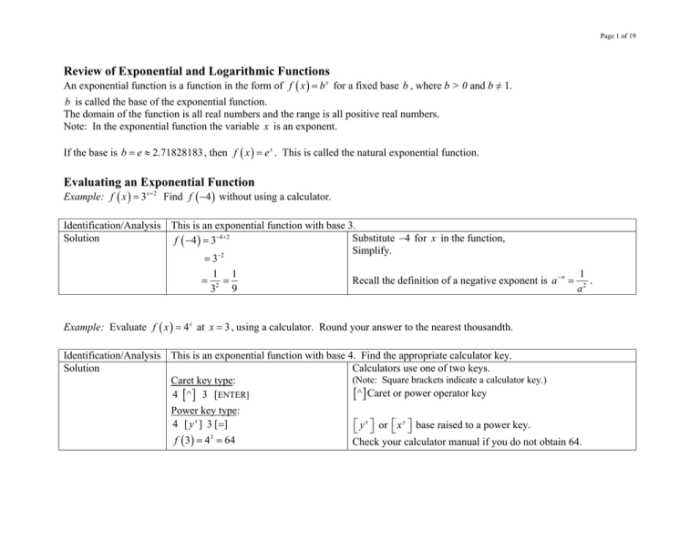Exponential and logarithmic functions unit test part 1 delves into the fascinating world of mathematical functions, providing a solid foundation for understanding their properties, applications, and interrelationships. This unit test is meticulously designed to assess students’ comprehension of these essential concepts, equipping them with the skills necessary to navigate complex mathematical problems with confidence.
Exponential functions, characterized by their rapid growth patterns, find widespread applications in modeling population growth, radioactive decay, and financial scenarios. Logarithmic functions, on the other hand, are intimately connected to exponential functions and play a crucial role in solving equations involving exponential expressions.
By delving into the intricacies of these functions, students gain a deeper appreciation for the power of mathematics in describing real-world phenomena.
Exponential Functions

Exponential functions are mathematical functions that describe the growth or decay of a quantity over time. They are defined by the general equation y = ax, where ais a positive constant called the base and xis the independent variable.
Exponential functions have several important properties. First, they are always positive for positive values of x. Second, they are increasing functions, meaning that as xincreases, yalso increases. Third, they have a horizontal asymptote at y = 0.
Examples of Exponential Functions
Some common examples of exponential functions include:
- y = 2x: This function represents exponential growth, where the value of ydoubles with each unit increase in x.
- y = 0.5x: This function represents exponential decay, where the value of yhalves with each unit increase in x.
Exponential functions have a wide range of applications in real-world scenarios, including population growth, radioactive decay, and financial modeling.
Logarithmic Functions: Exponential And Logarithmic Functions Unit Test Part 1
Logarithmic functions are the inverse of exponential functions. They are defined by the general equation y = loga(x) , where ais a positive constant called the base and xis the independent variable.
Logarithmic functions have several important properties. First, they are always positive for positive values of x. Second, they are decreasing functions, meaning that as xincreases, ydecreases. Third, they have a vertical asymptote at x = 0.
Examples of Logarithmic Functions, Exponential and logarithmic functions unit test part 1
Some common examples of logarithmic functions include:
- y = log2(x) : This function represents the logarithm of a number to the base 2.
- y = log10(x) : This function represents the common logarithm of a number.
Logarithmic functions have a wide range of applications in real-world scenarios, including pH calculations, sound level measurements, and computer science.
Relationship between Exponential and Logarithmic Functions
Exponential and logarithmic functions are closely related. The inverse of an exponential function is a logarithmic function, and vice versa. This relationship can be expressed by the following equations:
- loga(a x) = x
- aloga(x) = x
This relationship is useful for solving equations and inequalities involving exponential and logarithmic functions.
Unit Test Part 1
The following unit test is designed to assess student understanding of exponential and logarithmic functions.
Multiple Choice Questions
- Which of the following is the equation of an exponential function?
- y = x2
- y = 2x
- y = log2(x)
- Which of the following is the equation of a logarithmic function?
- y = x2
- y = 2x
- y = log2(x)
Short Answer Questions
- Describe the properties of exponential functions.
- Describe the properties of logarithmic functions.
Problem-Solving Questions
- Solve the equation 2x= 16 .
- Solve the equation log2(x) = 4 .
FAQ Corner
What is the significance of exponential functions?
Exponential functions are widely used in modeling phenomena that exhibit rapid growth or decay, such as population growth, radioactive decay, and financial scenarios.
How are logarithmic functions related to exponential functions?
Logarithmic functions are the inverse of exponential functions, meaning they undo the operations performed by exponential functions.
What is the purpose of unit tests in mathematics?
Unit tests are designed to assess students’ understanding of specific mathematical concepts and skills, providing feedback on their progress and areas for improvement.